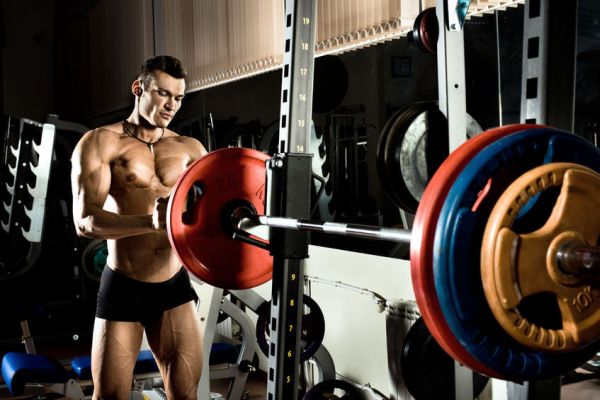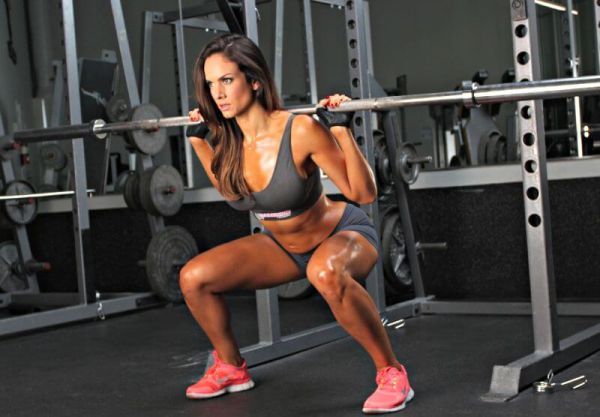Like the deadlift, the barbell squat is one of the most powerful exercises you can do, involving the strength and coordination of over 200 muscles in your body.
But, also like the deadlift, it’s avoided by many due to the fear that it’s bad for your back and knees.
The fact that many sports doctors say these things doesn’t help the squat’s cause. Consider, however, that these doctors specialize in treating people with injuries, many of whom should not be squatting in their current conditions. These people are not representative of the average, healthy gymgoer, however, and the advices that apply to those undergoing rehab don’t apply to everyone. Just because barbell squats can exacerbate a knee injury doesn’t mean it helps cause one in a healthy person.
Another common reason why these squat myths linger is even less scientific: just like how heavy, strenuous deadlifts look like they’re bad for your back (when they’re not, when performed correctly), intense squats look like they’re bad for your back and knees.
Well, to get to the bottom of these myths, let’s look to the anecdotal evidence of decades of weightlifters, and the scientific evidence of published literature.
Why Serious Lifters are in Love with the Squat

When it comes to leg training, there are usually two types of people.
The first loads up the Leg Press with every plate in the gym, and goes through an intricate ritual involving tourniquet-tight knee wraps, a weight belt cinched to its tightest notch, and pre-lift announcements and cheers. He then wiggles into the sled and grinds out a few excruciating half-reps, ending with an ear-splitting yell and high-fives with his buddies.
The other type? Well, he was in the corner with the squat rack—you know, the loneliest place in the gym—quietly going about his business with deep, heavy squats. No wraps, no belts, no swagger—just a bar bending across his back, loaded with a “measly” few hundred pounds, and a puddle of sweat on the ground.
Who’s the winner, in the end? Who will consistently get bigger and stronger, and who’s the least likely to get hurt? The latter, of course.
While many people will do anything for legs before putting the barbell on their backs, they’re missing out on what many of the top strength coaches in the world consider the absolute toughest and rewarding exercise we can do.
To nobody’s surprise, squatting strengthens every muscle in your legs, which in turn helps you not only lift more weight in the gym, but run faster, jump higher, and improve flexibility, mobility, and agility. As if those aren’t reasons enough to squat, it’s also an incredibly effective core workout.
That said, the biggest fears that keep people from including squats in their workout routines are worries of back and knee injuries. Are these valid concerns?
How Your Back and Knees Can Love the Squat Too

The myth that squatting is bad for your knees started with work done in the 1960s. Research concluded that a properly done squat stretched the knee ligaments, increasing the risk of injury. These findings spread like wildfire through the fitness world. Some US military services even cut squatting movements out of their training programs.
It was noted that the studies had serious flaws, including the choice of subjects and researcher bias (for instance, one of the studies was done with parachute jumpers, who often hurt their knees due to legs getting caught in parachute lines and violent impacts when landing), but that wasn’t enough to stop the uprising against the squat.
Well, much research has done since then, however, and a much different picture has emerged.
A rigorous study conducted by Duke University involved the analysis of over two decades of published literature to determine, in great detail, the biomechanics of the squat exercise and the stresses it places on the ankles, knees, hip joint, and spine.
Highlights from the study, and many others reviewed within, set the record straight on how the squat affects our bodies, and teach us a lot about proper squat form:
- While most of the attention is given to the knee, hip, and spine, ankle strength plays a large role in power generation during squat performance. Research has shown that ankle weakness actually causes faulty movement patterns during the squat.
- The hamstrings counter-act the pull on the shinbone, which helps neutralize the shearing force placed on the knee, and alleviates stress on the ACL.
- Sit back into the squat during descent and resist the urge to bring the knees beyond the toes, as this increases shearing force placed on the knees.
- Even in extreme cases, such as powerlifters lifting 2.5 times bodyweight, the compressive forces placed on the knee and its tendons are well within its ranges of ultimate strength.
- Stress placed on the ACL is negligible considering its ultimate strength (in one study, the highest ACL force recorded when squatting was a mere 6% of its ultimate strength). Highest recorded PCL forces were well within natural strength limits as well.
- Don’t let your knees bow inward at any point during the squat. Keep them in line with your toes.
- Squat depth matters–a lot. The deeper you squat, the more work your legs and butt have to do. (I recommend either full squats or parallel squats, but not half squats.)
- Full squats cause more muscle activity in the butt than lesser squat depths (you hear that girls?). (Use a wide stance too if you want to hit your butt even harder!)
- If you maintain a neutral spine position while squatting (instead of a rigidly flexed position), you greatly reduce the shearing force placed on your vertebrae (your spine is better at dealing with compressive force than shearing).
- Maintaining a posture as close to upright as possible further reduces this force, as does increasing intra-abdominal pressure, which you can create by holding your breath while you squat, and gazing straight ahead instead of down.
- Squatting rapidly doubles the amount of shearing and compressive forces placed on your knees. Keep your reps at a controlled pace to avoid this (I like a 2:1:2 pace—2 seconds down, pause, 2 seconds up).
- Avoid exaggerated rotation of the feed inward or outward, as they don’t make the exercise any more effective, and can potentially cause undesirable knee movements.
- While the low-bar squatting position produces less torque on the knees than the high-bar position, the magnitude of both forces are well within tolerable ranges, making neither position “better” than the other in this regard. Use whichever squatting position is most comfortable for you.
- The front squat produces significantly lower knee compression and low-back stress in comparison to the back squat, and thus can be a viable alternative for those suffering from various knee and back problems.
- Squatting while you’re fatigued can cause poor form, and is likely a contributing factor in both short- and long-term injuries. (This is one of my gripes regarding Crossfit, wherein participants are often urged to squat and deadlift heavy weights while fatigued—an injury just waiting to happen).
In closing, researchers concluded that the squat “does not compromise knee stability, and can enhance stability if performed correctly.”
Furthermore, any risks of spinal injury can be avoided by simply minimizing the amount of shearing force placed on the spine.
Let’s Get Squatting

According to the National Strength and Conditioning Association:
“Squats, when performed correctly and with appropriate supervision, are not only safe, but may be a significant deterrent to knee injuries.”
So rest easy: as long as you use proper squat form, the squat does not put your back or knees at risk of injury.
Oh and as a final note, don’t bother with the Smith Machine Squat. It forces an unnatural range of motion, which can actually lead to knee and back injuries, and research has shown it’s far less effective than the free weight, barbell squat.
What’s your take on the squat? Absolutely vital or overrated? Completely safe, or still a risk? Let me know what you think in the comments below!
Scientific References +
- Schwanbeck S, Chilibeck PD, Binsted G. A comparison of free weight squat to Smith machine squat using electromyography. J Strength Cond Res. 2009;23(9):2588-2591. doi:10.1519/JSC.0b013e3181b1b181
- Todoroff M. Dynamic deep squat: Lower-body kinematics and considerations regarding squat technique, load position, and heel height. Strength Cond J. 2017;39(1):71-80. doi:10.1519/SSC.0000000000000278
- Fry AC, Smith JC, Schilling BK. Effect of Knee Position on Hip and Knee Torques during the Barbell Squat. J Strength Cond Res. 2003;17(4):629-633. doi:10.1519/1533-4287(2003)017<0629:EOKPOH>2.0.CO;2
- Dionisio VC, Almeida GL, Duarte M, Hirata RP. Kinematic, kinetic and EMG patterns during downward squatting. J Electromyogr Kinesiol. 2008;18(1):134-143. doi:10.1016/j.jelekin.2006.07.010
- Vakos JP, Nitz AJ, Threlkeld AJ, Shapiro R, Horn T. Electromyographic activity of selected trunk and hip muscles during a squat lift: Effect of varying the lumbar posture. Spine (Phila Pa 1976). 1994;19(6):687-695. doi:10.1097/00007632-199403001-00008
- Race A, Amis AA. The mechanical properties of the two bundles of the human posterior cruciate ligament. J Biomech. 1994;27(1):13-24. doi:10.1016/0021-9290(94)90028-0
- Caplan N, Kader DF. Biomechanical analysis of human ligament grafts used in knee-ligament repairs and reconstructions. In: Classic Papers in Orthopaedics. Springer-Verlag London Ltd; 2014:145-147. doi:10.1007/978-1-4471-5451-8_35
- Paoli A, Marcolin G, Petrone N. The effect of stance width on the electromyographical activity of eight superficial thigh muscles during back squat with different bar loads. J Strength Cond Res. 2009;23(1):246-250. doi:10.1519/JSC.0b013e3181876811
- Caterisano A, Moss RF, Pellinger TK, et al. The effect of back squat depth on the EMG activity of 4 superficial hip and thigh muscles. J Strength Cond Res. 2002;16(3):428-432. doi:10.1519/1533-4287(2002)016<0428:TEOBSD>2.0.CO;2
- Escamilla RF, Fleisig GS, Zheng N, et al. Effects of technique variations on knee biomechanics during the squat and leg press. Med Sci Sports Exerc. 2001;33(9):1552-1566. doi:10.1097/00005768-200109000-00020
- Toutoungi DE, Lu TW, Leardini A, Catani F, O’Connor JJ. Cruciate ligament forces in the human knee during rehabilitation exercises. Clin Biomech. 2000;15(3):176-187. doi:10.1016/S0268-0033(99)00063-7
- Nagura T, Dyrby CO, Alexander EJ, Andriacchi TP. Mechanical loads at the knee joint during deep flexion. J Orthop Res. 2002;20(4):881-886. doi:10.1016/S0736-0266(01)00178-4
- Bell DR, Padua DA, Clark MA. Muscle Strength and Flexibility Characteristics of People Displaying Excessive Medial Knee Displacement. Arch Phys Med Rehabil. 2008;89(7):1323-1328. doi:10.1016/j.apmr.2007.11.048
- Escamilla RF. Knee biomechanics of the dynamic squat exercise. Med Sci Sports Exerc. 2001;33(1):127-141. doi:10.1097/00005768-200101000-00020
- Hartmann H, Wirth K, Klusemann M, Dalic J, Matuschek C, Schmidtbleicher D. Influence of squatting depth on jumping performance. J Strength Cond Res. 2012;26(12):3243-3261. doi:10.1519/JSC.0b013e31824ede62
- Comfort P, Haigh A, Matthews MJ. Are changes in maximal squat strength during preseason training reflected in changes in sprint performance in rugby league players? J Strength Cond Res. 2012;26(3):772-776. doi:10.1519/JSC.0b013e31822a5cbf
- Shinkle J, Nesser TW, Demchak TJ, McMannus DM. Effect of core strength on the measure of power in the extremities. J Strength Cond Res. 2012;26(2):373-380. doi:10.1519/JSC.0b013e31822600e5
- Solomonow M, Baratta R, Zhou BH, et al. The synergistic action of the anterior cruciate ligament and thigh muscles in maintaining joint stability. Am J Sports Med. 1987;15(3):207-213. doi:10.1177/036354658701500302










